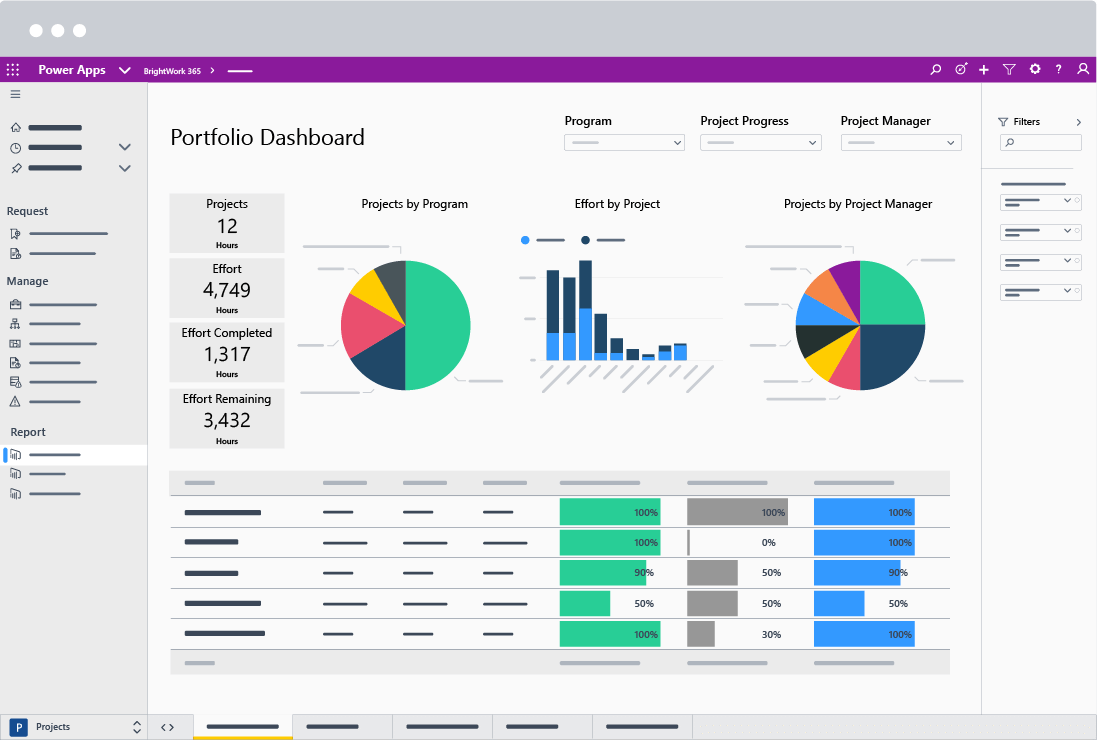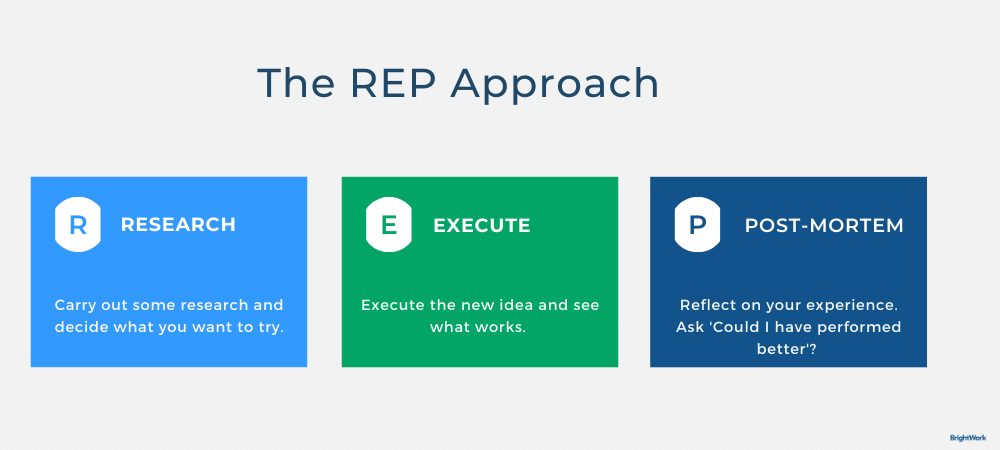For over a year, many teams and organizations worked remotely due to public health restrictions. Now, we’re moving towards something different: a choice in how and where we work.
Simplify project and portfolio management with BrightWork 365 in your Microsoft 365 Cloud [Read more]
Gartner estimates that “by 2022, 25% of the global knowledge workforce will choose their home as the primary workplace, and 45% of the workforce will be working from home two to three days per week.” It’s another big shift, bringing new opportunities and challenges. Teams and organizations have to decide what work looks like and how to become more agile, productive, and flexible.
Hybrid work, an approach that allows people to choose how they work, is becoming a popular choice in the ‘back to the office’ conversation. Organizations that opt for this route need to support teams with clear policies, defined outcomes, and the right collaboration software.
In this article, you’ll learn more about implementing a hybrid workplace with BrightWork 365, a complete project and portfolio management solution, deployed in your Microsoft 365 cloud environment.
What is hybrid work?
Hybrid work is a model that allows people to choose how, when, and where they work. Hybrid teams tend to focus on processes and outcomes rather than place and outputs, which are more commonly associated with office-based teams.
Hybrid workplaces can take many forms as teams work in the office or remotely to varying extents. Without the constraints of time and place, teams can choose to work in the office every day, get together on a weekly or monthly basis, or work remotely.
There are advantages and drawbacks to this approach.
Individuals and teams can rethink how they work and strive towards something better. Organizations can give teams more flexibility and autonomy. This leads to better retention rates and new hiring opportunities.
However, hybrid teams can feel isolated and disconnected from their peers. Without the right processes and tools in place, team members lose track of work and struggle to collaborate effectively.
How to get started with hybrid work
We need to let go of the idea that we can expect people to work together during certain hours and all in one place.
Hybrid Work: A Guide for Business Leaders (Microsoft)
Ideally, organizations allow individuals and teams to pick what works best for them, and look for ways to facilitate that model.
This starts with a clear understanding of what drives and hinders productivity, and how these elements are impacted by time and place.
It’s important to gather and listen to feedback from teams using surveys, workshops, and interviews.
The Microsoft guide to hybrid working also recommends asking:
- What can be done remotely?
- How do we maintain a safe workplace?
- How do we support people regardless of where they work?
- What processes should be digitized?
With this information, start to explore two key areas: people and processes.
You’ll also need to think about physical office space. Examples from Microsoft and Fujitsu are good starting points when considering changes to office layouts and technology.
Help teams make the switch
As teams transition to hybrid work, create clear policies around work practices. Let people know how, when, and where they can work, for example, everyone needs to be online during set hours, Monday to Thursday.
Next, build a remote-first workplace with a focus on practices and outcomes. This ensures everyone is included in key conversations whether they are based in a different country or just need to work from home on a given day.
Try simple tweaks like:
- Add a video link to every meeting.
- Ask everyone to join a meeting from their computer, even if they are in the same room.
- Use the same tools throughout the organization to manage projects and store key information.
- Document everything, including decisions, ideas, and feedback.
- Opt for asynchronous (non-real-time) communication as much as possible. This allows everyone to work on problems in their own time.
- Ask managers to give feedback more regularly, for example, monthly one-to-one sessions with their teams.
- Encourage teams to take regular breaks and avoid back-to-back virtual meetings.
Hybrid work relies on the right digital tools and processes. In the next section, we’ll take a closer look at how to use BrightWork 365 and Microsoft 365 apps to collaborate, report, and manage documents.
In addition to facilitating the hybrid workplace, Microsoft 365 apps are secure and compliant. This article outlines how key features such as Microsoft Defender, Azure Active Directory, and Sensitivity Labels protect hybrid workers.
Managing projects with BrightWork 365 and Microsoft 365
1. Collaborate with Microsoft Teams and BrightWork 365
Microsoft Teams is your hub for collaboration with everything from real-time chat to video meetings, whiteboards, and document management. Microsoft Teams supports both real-time communication, like a daily standup, and asynchronous communication, which allows individuals to read and reply to messages in their own time (and time zone).
Microsoft has also developed a range of hardware devices for Microsoft Teams, designed to work in any space.
Our free guide to Microsoft Teams will help you to get the most from this platform for hybrid working. As a quick recap, use Teams to:
- Run project meetings (ideally with video).
- Engage in group and one-to-one chats.
- Track work with Tasks in Teams and Lists.
- Store and collaborate on documents.
- Use whiteboards for brainstorms.
- Allow users to translate into the language specified in their language settings.
- Keep the team up-to-date with meeting recaps and transcripts.
- Collect feedback and suggestions with the Employee Ideas app.
BrightWork 365 integrates directly with Microsoft Teams. In BrightWork 365, every program has a dedicated Microsoft Team. Every project within the program has a channel within the Team. This allows your team to use the collaborative features of Microsoft Teams with project management processes and templates.
2. Manage documents with SharePoint Online and BrightWork 365
Hybrid teams rely on strong document management processes for two key reasons:
- People need easy access to the right files at the right time. No one should have to wait for a team member to come online to find information.
- Documenting ideas allows everyone to review, reflect, and contribute their input on their own time.
BrightWork 365 uses SharePoint Online for document management. Users can upload or create a new Word, Excel, or PowerPoint file, or add a new OneNote Notebook to the project to the project site.
To access more editing options, simply open the relevant SharePoint Online library from the project site and:
- Co-edit documents in real-time.
- Protect data with version control.
- Share files using links.
- Add workflows for review processes.
- Manage access with permissions.
All changes are synced instantly in BrightWork 365.
3. Save time with Power Automate and BrightWork 365
Getting work done is more complex in a hybrid team as people are no longer working in the same place at the same time. You’ll need to rethink how work is delivered. Look for paper-based processes that can be digitized and opportunities to automate repetitive tasks.
Having gathered these details, use a tool like Microsoft Power Automate to streamline workflows and processes. Power Automate is is a no-code/low-code drag-and-drop solution that allows users to create workflows to automate repetitive tasks and business processes.
The app is available on desktop, mobile, and Microsoft Teams, and as a browser app.
Power Automate works across Microsoft 365 and third-party apps, such as Google Drive, Dropbox, Twitter, and more. This allows your team to work with their preferred tools without losing a consolidated view of data and progress.
BrightWork 365 uses Microsoft Power Automate flows for essential project tasks, business processes, and reports. BrightWork 365 includes pre-built flows for project request management, task management, status reports, and Power BI dashboards.
4. Track progress with Power BI and BrightWork 365
Without real-time visibility into project data, your team can easily get stuck on last week’s problem. Getting actionable insight into the project is even trickier if the team is using different tools to manage their work.
That’s where Microsoft Power BI, a business intelligence tool, comes in.
Power BI allows anyone to collect and analyze data from multiple sources with no coding or statistical skills required.
Collaboration is simple with Power BI with options to add comments, share reports, use an app in Microsoft Teams, and create Workspaces for projects.
In BrightWork 365, Power BI delivers rich reports projects, programs, and portfolios, including timelines, resource allocation, milestones, and tasks.

Next Steps
Hybrid working will look different in every organization. At BrightWork, we like to use REP to manage big changes.

REP refers to Research, Execute, and Post-Mortem. When applied to hybrid working, it could work like this.
- Research: Spend some time researching best practices and learning from other companies. Collect feedback from your teams using Microsoft Forms and Employee Ideas, a Power App for Microsoft Teams. Create a prioritized backlog of ideas and initiatives.
- Execute: Implement the selected ideas and track how things work out.
- Post-Mortem: Make time to collect feedback and reflect on the outcomes. What worked? What didn’t work?
When you’re ready, start the cycle again!
To book your custom demo of BrightWork 365, please contact our team.
Editor’s Note: This post was originally published in July 2021 and has been updated for freshness, accuracy, and comprehensiveness.

